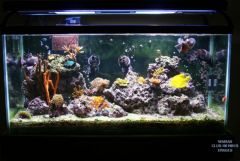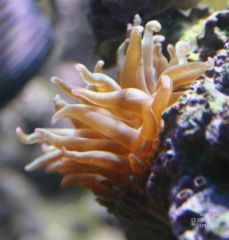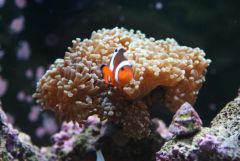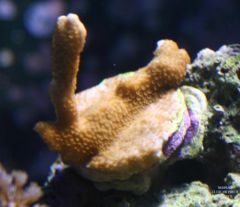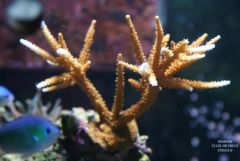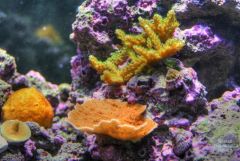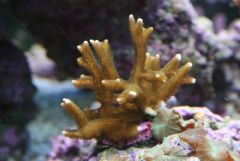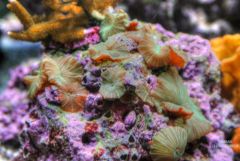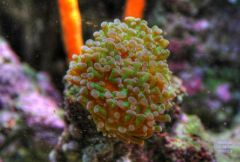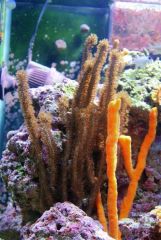-
Posts
21,561 -
Joined
-
Last visited
Content Type
Profiles
Forums
Gallery
Events
Store
Everything posted by Origami
-
With the dark tipped claws, it look like a young gorilla crab (or another xanthid crab) to me. Pest worth removing.
-
From the album: 90G Aquarium
Coming along. The orange dot in the front right corner of the aquarium is my purple condylactis anemone which started declining about 3 weeks ago. It never slimed up, just lost its tentacles and its size. I finally got rid of it when it could no longer attach itself decently to a surface. -
From the album: 90G Aquarium
Taken 17 April 2008. Acquired 6 March 2008. (dschflier's first BTA frag attempt) -
From the album: 90G Aquarium
28 April 2008. -
From the album: 90G Aquarium
28 April 2008. Acquired as a small frag from Mogurnda late Jan 2008. -
From the album: 90G Aquarium
28 April 2008. I lost a couple of small growth tips the other day while cleaning and mounted them on a frag plug. The frags are about 1/2 and 1/4 inch each. -

Orange Monti Plate, Green Bali Slimer, & Christmas Acro
Origami posted a gallery image in Member's Gallery
From the album: 90G Aquarium
28 April 2008. Christmas Acro (on plug to bottom left) came from Dave Lin. It's now fully encrusted on the plug and is a slow grower for me. The orange Monti plate came from Mogurnda and it's doing very well. The plate has begun to develop lobes and has at least doubled and maybe even tripled in size since January (?). the green Bali slimer is growing at a nice pace now. The two frags are now encrusted together and it's showing lots of growth these days. -
From the album: 90G Aquarium
Pic taken 28 April 2008. I probably should remove the mushroom that's encroaching on the Monti.... -
From the album: 90G Aquarium
I had a couple of loose mushrooms that had grown toward the back of the 29g Biocube that I bought from Steve Outlaw in December 2007. I fragged them into little pieces and set them onto a crushed coral surface in a cut down yogurt cup, covering them with bridal veil material. After the frags attached to the coral bits, I glued the bits to this rock in my 90g display. This is after about 2-3 months of growth. -
From the album: 90G Aquarium
28 April 2008. Looks like I could have cleaned my glass first, huh? -
Certainly, I don't think it's Pseudoplexaura. Could be Eunicea but could also be Plexaurella (different than either Plexaura or Pseudoplexaura). It would seem that the definitive answer would come from the presence of purple sclerites. If it has them, it's definitely Eunicea. If not, it could still be either since "nearly colourless" sclerites can still be present in Eunicea, though Sprung seems to imply that the colorless sclerites may belong to the species Muricea, which have a "distinctively prickly texture" (which ours do not have). You know, I'm struck by the color of your top picture. Recall Sprung's quote (above) that says, "They are light brown, almost yellow..." when describing Plexaurella. Interesting, huh?
-
Here you go, Dave. The polyps can retract further under some situations leaving little visible but you should get enough from this close-up, I hope. Tell me what you think. Sprung claims that, "Eunicea species usually have characteristic knobby projections for calyces that afford an Acropora-like appearance when the polysp are closed." But, he adds, "There are many species with strongly projecting calyces, such as E. laxispica, and some with relatively smooth branches, such as E. knighti." All of his pictures show forms with calyces that strongly project outward giving a pretty rough appearance (unlike mine in this photo). However, in the same reference, regarding Plexaurella, he writes: "They are light brown brown, almost yellow, with darker brown polyps. Small colonies are often shaped like a "Y", while large colonies are often bushy. Most Plexaurella spp. have crescent shaped pores when the polyps are closed, though some have round pores like the similar-looking Pseudoplexaura spp." In that same reference, Sprung shows a picture of the pores on one Plexaurella showing some slightly projecting calyces, and some others showing a rather smooth form.
-
Thanks, Dave. I think I'm going 'round and 'round on the ID. I'll post a pic tonight after forcing the polyps to retract. It does look like Eunicea but I didn't think the calyces looked to be as knobby as Eunicea when the polyps were fully retracted. In fact, when fully retracted, they look rather smooth (comparerd to what Sprung shows). I looked for the characteristic slit-pores of Plexaurella but didn't really think I had them. Sprung, however, leaves some latitude in the ID here claiming that some have round pores more like Eunicea. I kind of wish that I remembered what the cortex looked like after lopping off a lobed branch for dschflier about 2 months ago. That could have told me more, I think. Should you get a chance, take some pix of yours as well and we can compare.
-
Thanks, David. I'm expecting some Ushio's in the next few days. If I can get a PAR meter, I'm going to take a baseline measurement with my old bulbs and maybe swap them out early (holding onto them as backups) since they've only been in service since September '08. That would, hopefully avoid too much of a shift in the light output and let me see if I like the look.
-
Thanks, Gastone. I've got an electronic HQI ballast from Coralife. It's part of an all-in-one that I got when I started in the hobby. I've really never read much about it, I guess, but it is what I have and, for now, it seems to have done alright by me with the original 10K bulbs that came with it.
-
That reminds me. I should probably try to get my hands on the club PAR meter and collect a few baseline measurements. I'm going to give the Ushio 14K / Actinic 03 combination a try sometime in the near future to see how it goes.
-
Going back over the ID, I think I've decided that it's Plexaurella sp. Both Plexaurella and Eunicia sp. have darker polyps and can be somewhat knobby, according to Sprung's Quick Reference Guide. It's hard to get a close up view of the retracted polyp to see if it has the "slit-pore" characteristics of Plexaurella but the growth pattern (branching Y) and the allowance for rounder pores point more to Plexaurella. I hope that yours enjoys its new surroundings as much as mine seems to enjoy its home.
-
Kind of reminds me of my Caribbean gorgonian. I believe it's Plexaurella sp. (Corky Sea Fingers). I gave a frag of this to dschflier back in March.
-
From the album: 90G Aquarium
Received from Tampa Bay Saltwater, September 2007. Picture taken April 26, 2008. Frag of this given to dschflier (David) in March 2008. -
I have one of those all-in-one lighting setups comprised of 2x 150W 10,000K HQI MH plus 2x 96W PC Actinic 03 plus 4x moonlight LED's. Hellolights has announce a 10% off sale for today and tomorrow and I'm probably going to take advantage of it. At nearly $60 each, I'd rather not "experiment" too much with this light or that light before finding something I like (though that may be inevitable). I've heard that Ushio 10K bulbs have good PAR but are a little yellower than XM bulbs, which I've heard described as being a "crisp white." I kind of think that my current Coralife 10K MH bulbs are rather crisp but I have nothing really to compare them to. What kind of look can I expect between the Ushio and the XM when coupled with the nearly 200W of Actinic 03? I welcome your opinions. Thanks!
-

alternative for drilling an established tank?
Origami replied to treesprite's topic in Do It Yourself
Forrest, you have a pretty innovative idea and I think that's pretty cool that you're thinking outside the (overflow) box. But I have to agree that you're best course is down one of two tried-and-true paths: Drill your tank or use an overflow box (which you have). After all, the extension idea could still fail if one of those add-on seams failed over time because of thermal expansion mismatches, repeated pressure of reaching over and into the tank. In that case, you could be looking at even more water being released. Not good at all. I've got a CPR overflow on my 90 but really wish now that I'd listened and had the tank drilled (the problem was that I initially wasn't intending on using a sump but quickly decided to add one after I'd set up the tank). I've even considered partially draining the tank and drilling it in place but I don't have much room behind the tank to get a drill and bit in unless I get a drill with a right-angle chuck. In my case, my overflow is actually rather quiet (It seems sometimes that I've done a lot to get it that way, too - going so far as to re-invent what I later found out was already known as a Stockman standpipe). Not whisper silent, though, like what Bob (Lanman) has. Also, I've not had problems with my line to my aqualifter coming loose (I think I'm going to go put a nylon tie wrap on it now, for extra security!). I also try to keep my aqualifter and the airline on my maintenance schedule so I'm not surprised. Finally, the return pump section of my sump and display's water level, as well as the water level in the sump and of the siphon-break in my tank's return line, and the are such that either a loss of siphon or a loss of power (respectively) will not cause an overflow of either - there's enough capacity in each to handle whatever comes along. The only way I should get water on the floor is if there's a physical failure of the plumbing. I have heard nothing but good things about Lifereef overflow boxes, though I've never owned one. If you want to mitigate the risks of future spills, I'd consider taking two actions. First, re-evaluate how your water levels in both your display and your sump are set up and size them appropriately to make sure you have capacity to deal with power outages and overflow failure. Second, if your concerned about aqualifter failure, get an overflow box that has a history and reputation of maintaining siphon long term without one (such as a Lifereef). The only reason that I see for having an aqualifter on my overflow is because the water velocity through the broad "tube" of the CPR design is not quick enough to clear the air that inevitably gathers at the top of the box and which can break siphon. Good luck. I look forward to hearing what direction you will take. -
It definitely looks like solid-core NM cable used in the melevsreef application. It is a little less flexible but since you've got a semi-permanent installation inside your stand, solid core just be a little more difficult to work with initially and the length might be a little more critical as taking up slack would be a bit more of a pain with solid core. But once you had it installed, it would work fine. I think you could just as easily use some decent heavy-duty stranded that is made for extension cord applications and probably be just as good if not better (easier to work with, more flexibility so you're not forcing kinks to adjust your routing, a little more abrasion resistance, etc.). As for durability, I think that (extension cord) stranded is made for applications requiring physical flexibility, survival through repeated flexes across a tight bend radius, etc . Solid core would find itself sorely lacking in that department and would fail far sooner. The same goes for abrasion resistance. Most solid core is sheathed for a permanent installation where long-term rubbing (after initial installation) is unlikely to be an issue. There are advantage to each in their different applications - that's why the two exist. For the same gauge and conductor material (copper), solid core should have less voltage drop per foot than stranded when carrying line power. (Unlikely to be an issue in a short run application like your stand.) I'm gathering that because these "extension cords" are interior to the stand that these are short runs, too? Whatever path you opt to take, you might want to consider how you can better seal the plug (that you plan to install) housing to wire interface to prevent salt creep up into the plug housing. You may find that a shrouded plug will fit extension cord wire better than NM (non-metallic sheathed) Romex type cable. I've not really compared prices recently but I suspect that solid core is likely to be less expensive by the foot because you will probably find it easier to locate a bulk box of NM and would have to pull the stranded off of some by-the-foot reel at HD or Lowes. Brian's right on though about Code: It's against code to permanently install extension cords (or stranded) into living structures (like the walls of houses and office buildings) for normal power distribution. There's nothing that would restrict you from wiring your "furniture" that way, though. After all, most of the pre-wired office workstations that I've seen are wired with stranded wire and that's analagous in the sense that it's a "permanent" installation into furniture.
-

alternative for drilling an established tank?
Origami replied to treesprite's topic in Do It Yourself
Curious, Forrest. If all you're doing is trying to get an overflow to your sump and you don't want to drill your tank, why are you not considering a siphoning overflow box? Or is that what you're trying to remove (the "hot" box) with this approach? -
Wally, are you wiring your home or your stand? If you're basically creating an extension cord with a boxed end that would mount in your stand (as I originally interpreted your post), you're OK to use stranded, I believe. If you're installing permanent wiring for your home, then you've got to use solid-core rated for the space and application.



